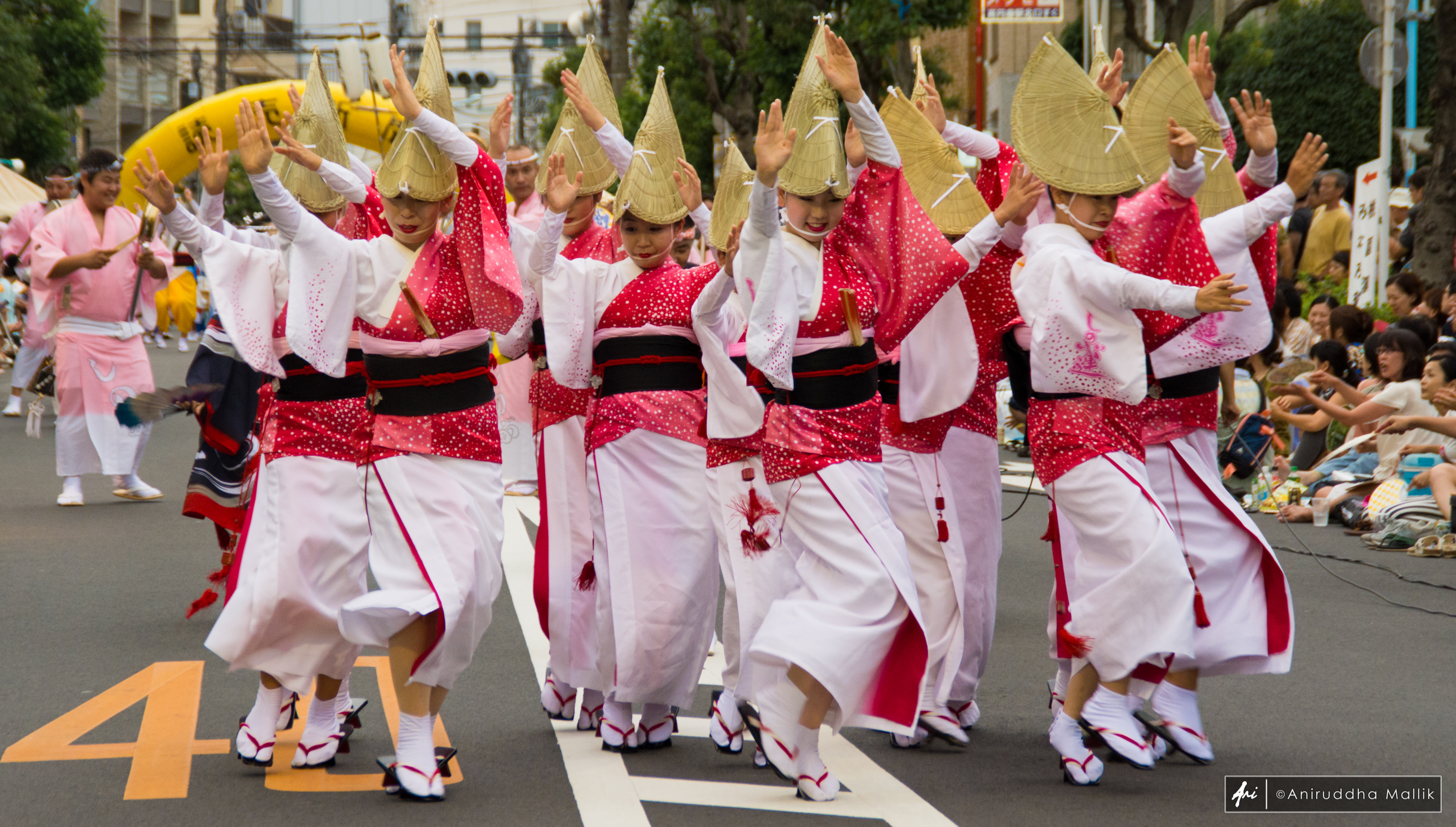The 58th Koenji Awaodori was held near Koenji station in Tokyo on August 24th 2014. I have seen photographs of this event before and been especially inspired by my photographer friend Jason Arney to actually take up the challenge of capturing the sights and sounds of the Awaodori myself.
The Awaodori is held in the month of August every year and started first in Tokushima prefecture, where more than 1.5 million tourists come together to make it the largest festival in Japan. The Koenji Awadori (in Koenji, Tokyo) is said to be the second largest festival of Japan and is an absolute spectacle!
The song associated with Awa Odori is called Awa Yoshikono and is a localised version of the Edo period popular song Yoshikono Bushi. Parts of it are sung, and others are chanted. The origins of the melodic part have been traced to Kumamoto, Kyūshū, but the Awa version came from Ibaraki Prefecture, from where it spread back down to Nagoya and Kansai. The lyrics of the first verse are:
Awa no dono sama hachisuka-kou ga ima ni nokoseshi awa odori
What Awa’s Lord Hachisuka left us to the present day is Awa Odori
The song is usually sung at a point in the parade where the dancers can stop and perform a stationary dance — for example a street intersection or in front of the ticketed, amplified stands which are set up at points around the city. Not every group has a singer, but dancers and musicians will frequently break out into the Awa Yoshikono chant as they parade through the streets:
踊る阿呆に Odoru ahou ni The dancers are fools
見る阿呆 Miru ahou The watchers are fools
同じ阿呆なら Onaji ahou nara Both are fools alike so
踊らな損、損 Odorana son, son Why not dance?
The dancers also chant hayashi kotoba call and response patterns such as “Yattosa, yattosa”, “Hayaccha yaccha”, “Erai yaccha, erai yaccha”, and “Yoi, yoi, yoi, yoi”. These calls have no semantic meaning but help to encourage the dancers.
During the daytime a restrained dance called Nagashi is performed, but at night the dancers switch to a frenzied dance called Zomeki. As suggested by the lyrics of the chant, spectators are often encouraged to join the dance.
Men and women dance in different styles. For the men’s dance: right foot and right arm forward, touch the ground with toes, then step with right foot crossing over left leg. This is then repeated with the left leg and arm. Whilst doing this, the hands draw triangles in the air with a flick of the wrists, starting at different points. Men dance in a low crouch with knees pointing outwards and arms held above the shoulders.
The women’s dance uses the same basic steps, although the posture is quite different. The restrictive kimono allows only the smallest of steps forward but a crisp kick behind, and the hand gestures are more restrained and graceful, reaching up towards the sky. Women usually dance in tight formation, poised on the ends of their geta sandals.
Children and adolescents of both sexes usually dance the men’s dance. In recent years, it has become more common to see adult women, especially those in their 20’s, dancing the men’s style of dance.
Some of the larger ren (dance groups) also have a yakko odori, or kite dance. This usually involves one brightly dressed, acrobatic dancer, darting backwards and forwards, turning cartwheels and somersaults, with freestyle choreography. In some versions, other male dancers crouch down forming a sinuous line representing the string, and a man at the other end mimes controlling the kite.
Why shooting this event is a challenge is that the main road is closed off so that the performers can have an open and unobstructed space to perform and also so that the massive number of spectators can be properly managed. What this means is that if you are unable to get hold of a strategic location right in front as the groups move up the road, you’ll end up with photographs from one side and will miss out on the beautiful formations that the dancers make. Some people, like Jason (:)), put in extra effort to get a “lane permission” which allows them to get into the restricted area and move around with the performing groups. But for the lesser mortals like myself, I had to scout around the area looking for the right spot and managed to position myself at the end of the road where the performers do their last moves and then end before moving out of the area. This gave me a frontal view of the groups and with the help of a 18-200mm zoom lens, I had the flexibility of taking either long and wider shots or zoomed in close-ups.
Besides the main road, the groups also move down a much narrower “shotengai” (shopping lane) where the restrictions are more difficult to enforce because of the narrow space. The advantage for photographers here is that they can move around and also get really close to the performers, thus getting a different perspective in their photographs. I spent about an hour and a half on the main road and then moved into the shotengai. The shotengai though presents a very challenging lighting environment due to the street lamps, ambient and inconsistent store lights, etc.. So getting the right white balance and shutter speeds and apertures was easier said than done! I used a 50mm 1.8 lens here, but I wished I had a 24mm 1.2, which would have allowed me to get a wider frame and faster shooting ability. I had a 24mm 3.5 at home and I am not sure if using it would have been better, but nevertheless, the overall experience was fantastic and I learnt a lot from it. Moreover, I did manage to get a lot of photographs which I am quite happy with…. they could be a lot better, but for a first attempt, I’m not too unhappy! 🙂 One thing I did realise after this event was that all the photowalks that I have been part of in the last couple of years have made me much more comfortable about moving up close to the subject and daring to take photographs. And this really helped because in street festivals like the Awaodori, being able to move really close to the performers can give you some brilliant shots that capture their true emotions and spirit.
Here are some photos from the event (click on the image below to view the entire album). Hope you like them, and as usual, feel free to post your comments… good and bad!
Yatto yatto sa!! 😀
Cheers!
Ani.


